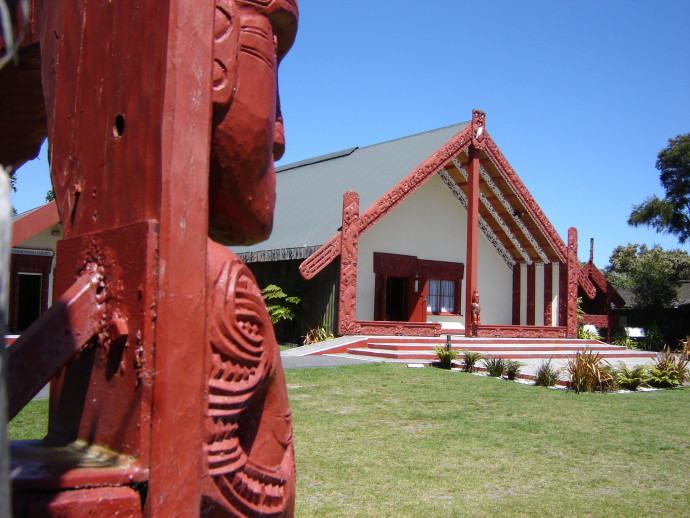Research
Published 18 January 2023A question of identity: How connected are young Māori to ancestral marae, and does it matter?

Does belonging to marae matter to young Māori?
Most Māori people live away from their ancestral home marae. Evidence suggests Māori seek, but struggle, to remain connected to their marae, language and culture. Home marae communities, generally depopulated and geographically isolated, also seek to strengthen contact with their dispersed descendants. But does belonging to marae matter to young Māori?
In wanting to hear directly from our rangatahi, Professor Merata Kawharu (University of Otago) and her team of researchers have been speaking to students in high schools throughout Aotearoa to investigate difficult issues about marae hono connection and identity. Although Covid-19 has disrupted parts of the research, schools are eager to join the programme, with teens from Tāmaki Makaurau Auckland, Rotorua, Te Whanganui-a-Tara Wellington, Ōtautahi Christchurch and Ōtepōti Dunedin excited to participate.
Te Kaupapa | The Project
Using kaupapa Māori and social network frameworks, this Marsden Funded research aims to advance theories of Māori cultural change using 'marae' as the pivotal indicator. The research will also deepen awareness of the diverse needs in Aotearoa and aspirations of young Māori and their marae people today.
Students participated in a survey that asks if they have any connections with their ancestral marae before being asked their views about how connections should be strengthened. These questions are vital in detailing both physical and spiritual barriers; significant for many young people and their whānau who are geographically far from their marae.
Hono Tāngata | Connecting People
Perhaps unsurprisingly, the team has found that digital means such as the internet and social media are important in building and strengthening connections for rangatahi and their marae. Things like online workshops on tikanga, mātauranga and kōrero relating to the marae and other online forums are popular ideas. Interestingly, Covid facilitated connections as marae/hapū developed initiatives during the pandemic that steered young people toward ‘meeting’ their extended whānau for the first time. Also being explored in the survey are kānohi ki te kānohi face-to-face learning programmes at marae for rangatahi which offer a variety of cultural, social, environmental, and economic kaupapa topics.
While the extent of interest among rangatahi has been an eye-opening feature of the research, the little engagement of whānau who live far away has also been underscored. This is perhaps not surprising given the geographic distance, if not the cultural disconnection between whānau and marae if whānau have not maintained strong connections over a number of years. An important barrier to overcome bringing whānau home is whakamā shyness, or an uncertainty about what coming home means, looks like and is about. The team have begun talking to marae about these issues since many are reaching out to their whānau. They are particularly interested in barriers or challenges to help identify what needs to be addressed to then help strategise and plan easier pathways for all. While marae may run programmes for young people, this research suggests that building wider networks with distant kin and other members who don’t often visit their home marae are essential if long-term sustainability and relevance to whānau are to be progressed.
It’s also important to find innovative ways to either fund whānau to come home for programmes or to find other ways of bringing them home. In turn, findings suggest local or central government might do more to support these community development initiatives, especially when community development is ‘policy’ and where marae communities have limited financial means. Supporting marae in these ways also means supporting marae and whānau expressions of rangatiratanga self-determination. Likewise, schools themselves play a crucial role in the lives and development of young people.
Building hono connections into the future
This research builds on specific existing initiatives for strengthening connections with marae like www.maorimaps.com – a tool developed by one of the researchers, Professor Paul Tapsell and team. They anticipate that schools will use this website too, as part of providing space in their learning programmes to help strengthen connections, knowledge and understanding about the place of ancestral marae.
The findings from this study will provide vital knowledge regarding how whānau, marae, hapū and others can navigate through complex circumstances of our time. With respect to place, nowhere else in the world do living marae exist. It is a defining feature of our people and our nation. This research will therefore offer leading insights and strategies from Aotearoa and contribute to discussions on similar issues facing Māori hāpori communities, and other indigenous peoples internationally regarding home connection and identity.
RESEARCHER
Merata Kawharu (Principal Investigator), Dr Paul Tapsell (Associate Investigator), Dr Krushil Watene (Associate Investigator), Dr Stephen McTaggart (Associate Investigator)
ORGANISATION
University of Otago
FUNDING SUPPORT
The Marsden Fund
CONTRACT OR PROJECT ID
UOO1832
